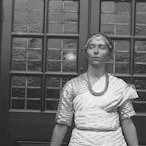| Ruby Ginner | |
|---|---|
 at the Women's Freedom League in 1912 (by Christina Broom) at the Women's Freedom League in 1912 (by Christina Broom) | |
| Born | (1886-05-08)8 May 1886 Cannes, France |
| Died | 13 February 1978(1978-02-13) (aged 91) Newbury, Berkshire, UK |
| Nationality | British |
| Other names | Ruby Ginner Dyer (after marriage) |
| Occupation(s) | Dancer, dance educator |
| Relatives | Charles Ginner (brother) |
Ruby Ginner (8 May 1886 – 13 February 1978), later Ruby Ginner Dyer, was a British dancer and dance educator, born in France. She founded a dance school, and the Association of Teachers of the Revived Greek Dance.
Early life
Ruby Mary Adeline Ginner was born in Cannes, and moved to England at age 11. Her father Isaac Benjamin Ginner was a doctor. Her mother Lydia Adeline Wightman was born in Scotland. Her older brother Charles Ginner became a noted painter. She trained in ballet, and studied Greek dance.
Career

Ginner was principal dancer with the Beecham Opera Company from 1910 to 1912, then led a group of dancers performing her interpretation of Greek dance from 1913. She and her dance troupe performed at a fund raiser for the British Red Cross Society in 1915. She danced on the London stage, in An Autumn Idyll (1912), Et pois bonsoir (1920), The Trojan Women (1920), Medea (1920), and L'enfant prodigue (1929).
Ginner founded the Ruby Ginner School of Dance in London during World War I. She later partnered with mime Irene Mawer, and the school was known as the Ginner-Mawer School of Dance and Drama. Among her students was Australian health advocate Thea Stanley Hughes, Canadian dancer Gweneth Lloyd, actress and dancer Irene Mulvany-Gray (and her sister Hilda Mulvany-Gray) and dance educator Beatrice "Bice" Bellairs. She taught movement to actors at Constance Benson's studio, including a young John Gielgud.
In 1923, Ginner founded the Association of Teachers of the Revived Greek Dance; the organization became the Greek Dance Association, and in 1951 joined the Imperial Society of Teachers of Dancing. She was decorated for her services with the Red Cross in Greece during World War II.
Books by Ginner included The Revived Greek Dance: Its Art and Technique (1930) and Gateway to Dance (1960). Ginner offered Greek dance as a healthier, more natural way of expressive movement than more modern dance traditions:
The natural physical rhythms of mankind are being slowly crushed out of existence. In many of the arts and crafts, in the daily necessities of life, in labour, and in travel, the free, glorious, and rhythmic movement of the body has given place to the action of the machine.
Personal life
Ruby Ginner married Alexander Dyer. They had a home called St Corentin, in Boscastle, Cornwall, where her brother painted landscapes from 1915 to 1947. Ginner died in 1978, aged 91 years, at a nursing home in Newbury. Her papers, including photographs and films, are in the National Resource Centre for Dance at the University of Surrey. The Ruby Ginner Awards are presented annually by the Imperial Society of Teachers of Dancing.
References
- ^ Hartley, Cathy (2003). A Historical Dictionary of British Women. Psychology Press. p. 184. ISBN 978-1-85743-228-2.
- Baron, Wendy. "Ginner, (Isaac) Charles (1878–1952), painter". Oxford Dictionary of National Biography (online ed.). Oxford University Press. doi:10.1093/ref:odnb/33410. Retrieved 2020-04-07. (Subscription or UK public library membership required.)
- "Charles Ginner 1878-1952". Tate. Retrieved 2020-04-07.
- ^ "Ruby Ginner". The Oxford Dictionary of Dance. Retrieved 2020-04-07.
- "Topical Budget 202-2: Grecian Dances at Ranelagh (1915)". BFI Screenonline. Retrieved 2020-04-07.
- G. (1912-06-26). "'The Cicada' at the Savoy Theatre". The Guardian. p. 5. Retrieved 2020-04-07 – via Newspapers.com.
- Wearing, J. P. (2014-03-27). The London Stage 1920-1929: A Calendar of Productions, Performers, and Personnel. Rowman & Littlefield. pp. 14, 17, 643. ISBN 978-0-8108-9302-3.
- Carter, Alexandra (2016). "Ginner, Ruby (1886–1978)". Routledge Encyclopedia of Modernism. Retrieved 2020-04-07.
- ^ Carter, A.; Fensham, R. (2011-12-02). Dancing Naturally: Nature, Neo-Classicism and Modernity in Early Twentieth-Century Dance. Springer. p. 21. ISBN 978-0-230-35448-7.
- "Meet the Artists: Gweneth Lloyd". ArtsAlive. Retrieved 2020-04-07.
- "Enrolment Starts in Play Workshop". The Gazette. 1944-11-07. p. 4. Retrieved 2020-04-08 – via Newspapers.com.
- "Mimetic Dancing Releases Feeling". The Gazette. 1936-04-27. p. 8. Retrieved 2020-04-07 – via Newspapers.com.
- ^ "Pioneer Women: early British modern dancers" National Resource Centre for Dance (2008-2010).
- Croall, Jonathan (2011-05-05). John Gielgud: Matinee Idol to Movie Star. A&C Black. ISBN 978-1-4081-3107-7.
- Khan, Naseem (1967-06-09). "The Grecian Gambol". The Guardian. p. 10. Retrieved 2020-04-07 – via Newspapers.com.
- Mitchell-Smith, Susan (October 2001). "Classical Greek Dance Centre (Ruby Ginner Method)". Dance Research. 19 (2): 127. doi:10.3366/1290979. ISSN 0264-2875.
- ^ Ginner, Ruby (1933). The revived Greek dance : its art and technique. London : Methuen & co., ltd.
- Ginner, Ruby (1944). The Revived Greek Dance: Its Art and Technique. Methuen.
- "Ruby Ginner". Ancient Greek Dance Revival. Retrieved 2020-04-07.
- Ley, Graham. "Modern Visions of Greek Tragic Dancing" Theatre Journal 55(3)(October 2003): 467-480. via ProQuest.
- Evans, Mark (2009-01-13). Movement Training for the Modern Actor. Routledge. p. 47. ISBN 978-1-135-89294-4.
- Jenkins, David Fraser; Perry, Roy; Morgan, Sarah (2012-05-01). Hartland Point from Boscastle 1941 by Charles Ginner. Tate. ISBN 978-1-84976-385-1.
- CARTER, ALEXANDRA (2010). "Archives of the Dance (22): Pioneer Women - Early British Modern Dancers (The National Resource Centre for Dance, University of Surrey)" (PDF). Dance Research: The Journal of the Society for Dance Research. 28 (1): 90–103. doi:10.3366/drs.2010.0005. ISSN 0264-2875. JSTOR 40664451.
- "Ruby Ginner Awards 2019". Imperial Society of Teachers of Dancing. Retrieved 2020-04-07.
External links
- Christina Broom (1912), "Ruby Ginner at the Women's Freedom League International Suffrage" in the Museum of London.